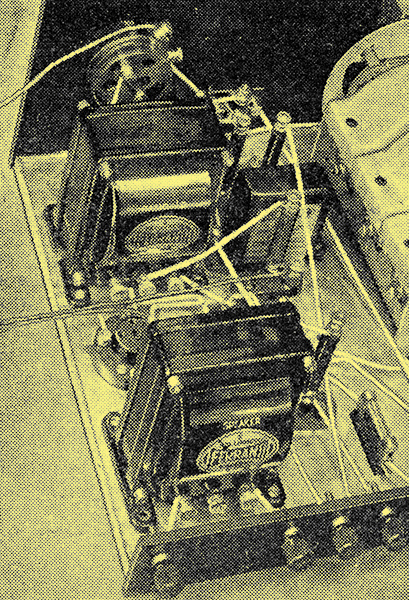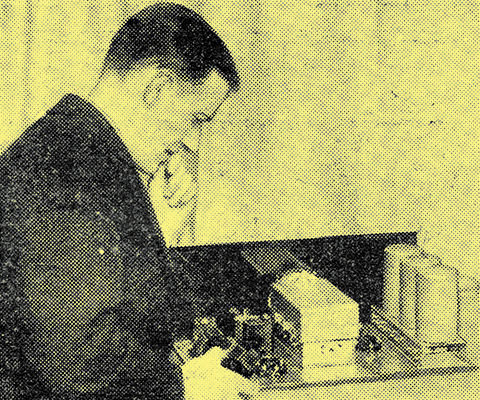|
Has Class B come to stay is a question which thousands of enthusiasts must have asked themselves during the past few weeks. No one wants to spend time and money on what may prove to be a passing fashion, but this authoritative article on radio's latest development will set many minds at rest.

Extremely good volume with low HT consumption is achieved by employing the QPP method of push-pull. Class B, however, provides a similar economy and gives the same output, but only requires one valveholder, and a less complicated circuit.
In one respect after another we are moving back to the pre-broadcast and even pre-war days of radio. That may seem a strange thing to say about such an up-to-the-minute development. But just think of a few examples.
In 1920 and thereabouts the ambition of every experimenter who could afford the extravagant upkeep was to have a superhet. Is it much different now, apart from the upkeep consideration.
In the early days of the war the famous push-pull patent was applied for, and it is perhaps not generally realised that this is a strictly QPP patent, and that the type of push-pull used, until recently, was a later development. New we have gone back to QPP.
Back in Favour
The type of valve detector used in 1905 - many of you were not born then! - was the diode. Now it is back in favour.
In 1877 (!) Siemens patented a moving-coil sound reproducer. He evidently had the right idea. It is too much to ask if you remember what Siemens did in 1877, but perhaps some of you remember the type of output stage used in 1923? The same sort of high-impedance valve as was used for the detector (because it was Hobson's choice) and no bias! It is not a great risk to one's reputation to prophesy that these features will be strongly represented in the coming season.
Of course, it will not be quite the same; these revivals never are. The terrible distortion that tortured the air in the period around 1923 will not be reintroduced. But perhaps it would be better to explain all about it.
The new method has been named by the Americans, for reasons best known to themselves, Class B, amplification. And we quite meekly adopt the terms used across the water, however ridiculous. In America it is largely used to obtain an extremely high-power mains-driven output, but we are content with rather less aggressive reproduction, and have decided to make use of its merits in helping the down-trodden battery user. In some respects it resembles QPP, and the underlying principle is the same, but there are important differences, which it is the purpose of this article to explain.
Wickedly Wasteful
What is the idea of QPP? It seeks to take advantage of the fact that it is only momentarily and very rarely that a powerful output stage is called upon to stretch itself to the full extent, and when battery power is so costly it is wickedly wasteful to pour into the valve as much HT current to reproduce the muffled interval signal or the dying whispers of soft music as to stir the neighbourhood with every one of the 117 BBC orchestrians making his or her loudest noise. Grid bias is, therefore, applied to about double the usual amount; so that when no Sound is being reproduced, approximately no current is being drawn.
This being the case, the valve effectively attends only to the positive half-waves, because the negative half-waves would require the anode current to become less than zero in order, to reproduce them, and that cannot happen with a single valve. So another valve is used in such a way that its anode current flows through the output transformer in the opposite direction, and that is just as good as a negative current.
Thus one valve deals with the positive half-waves and the other with the negative half-waves, and their contributions being brought together again by means of the output transformer, a perfectly good and complete up-and-down wave results.
And a very good idea it is, too, because, instead of being like a horse, eating just as much when doing nothing as when working hard, it is like a car that consumes fuel according to how big a load it is pulling. On top of that, QPP is nearly 100% more economical, even when working at full power; a fact that seems to be over looked, but one which is capable of theoretical and practical proof.
The Full Benefit
There are, however, certain irritating little drawbacks in applying QPP that we should like to do without.
For example it is necessary to use pentodes to realise the full benefit of the system. Now two pentodes cost a good deal more than one triode, and, in fact, constitute the biggest discouragement to those looking longingly at the resulting economy in upkeep.
Then while pentodes give very satisfactory quality when everything is just right, it is not possible to depart very far from the ideal loudspeaker, transformer, etc. Without departing seriously from satisfactory tone. The grid bias, too, is rather a worry. Unless it is just right, there is bad distortion or loss of economy, or both. And it has to be kept just right when the HT battery voltage falls with use.
And the two valves have to be kept balanced so that they share the load equally. In addition there are two auxiliary grids to keep supplied with current. So from the point of view of the man, and still more, far more, of the woman, who wants to get good results without, fiddling, QPP leaves some things to be desired.
Even Better Characteristics
These things are supplied by Class B. Instead of the two pentodes there are two triodes in one bulb; so there is a saving in both cost and space. The latter is important to those converting their sets because it is annoying and unsightly to have an extra valve overflowing for lack of room. In spite of this the characteristics of the valve are even better than pentodes. So far as matching is concerned that is the manufacturers funeral. The valve has been matched by them at zero bias, and there is no difficulty in keeping it matched, because zero bias does not require much maintenance.
What then is wrong with Class B? The only objection that can be urged against it is that it requires a special technique as regards the input circuit. The distinctive feature is that there is no grid bias. That means that grid current flows during the positive half-wave of signal, and does not flow during the negative half.
The Current is Very Small
With the usual system that would have two unpleasant effects. It would mean first that the valve or valves would draw an altogether ruinous current from the HT battery, and both valves and battery would rapidly perish. But in Class B valves that little worry is attended to by the valve designers, who arrange that when there is no bias the anode current is very small indeed.
Then the grid current would make it heavy going for the input transformer, because the current would flow just during the moments when the transformer made the grid positive, that is to say, when the valve would be doing its share. It would mean, in fact, that the half of the input transformer, which at any given moment would be responsible for passing on the signal, would be nearly short-circuited by the low impedance path from filament to positive grid. One might exclaim with the Savoyards 'Here's a how-de-do!'
But the difficulty can be overcome by making the input transformer of low impedance, too, which is done by giving it a step-down ratio instead of a step-up. That means loss of amplification. Very sad, but one gets 'owt for nowt, in this hard world. We can dry our tears by reflecting that, after all, modern valves and components make a step-up quite unnecessary if there is a valve in between the detector and the output.
No Auxiliary Grids
Such a valve, together with the Class B valve, can be made to take no more HT or LT than the two valves that would be required for QPP, so that even if the Class B requires an intermediate valve and the QPP doesn't, they can be strictly compared. And it has no auxiliary grids to worry about. The intermediate valve should be of rather low resistance, not more than 20,000 Ω at the most, and a step-down transformer of about 2:1 is right.
On the output side the requirements and the results generally are not greatly different from those of QPP, except that the transformer can be designed for a lower valve resistance, which is another point in favour of Class B To most minds, then, the considerable number of points at which Class B, shows an advantage is likely to prevail against the one material disadvantage of the system.

|